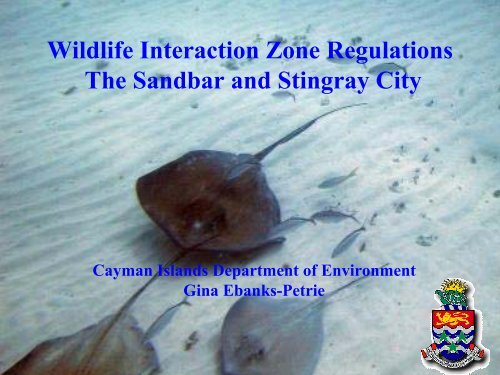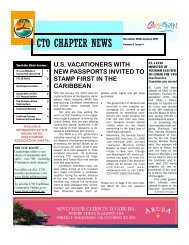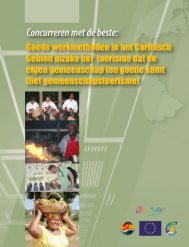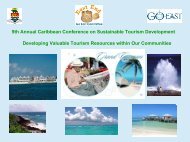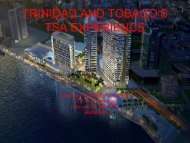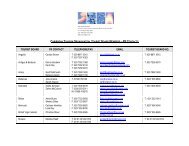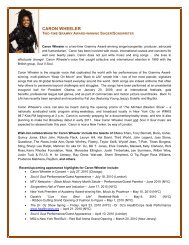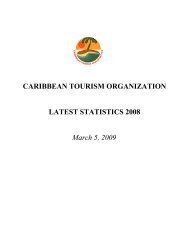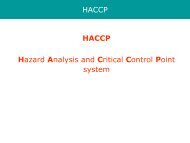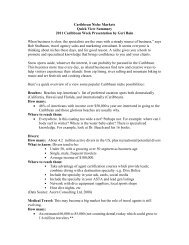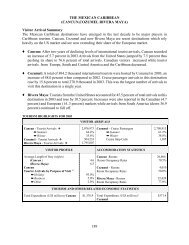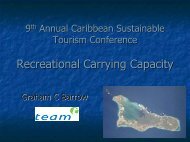Stingray City - Caribbean Tourism Organization
Stingray City - Caribbean Tourism Organization
Stingray City - Caribbean Tourism Organization
You also want an ePaper? Increase the reach of your titles
YUMPU automatically turns print PDFs into web optimized ePapers that Google loves.
Wildlife Interaction Zone Regulations<br />
The Sandbar and <strong>Stingray</strong> <strong>City</strong><br />
Cayman Islands Department of Environment<br />
Gina Ebanks-Petrie
Location of the Sand Bar/ <strong>Stingray</strong> <strong>City</strong>
Sand Bar – Grand Cayman
Early Concerns<br />
• Primarily centered on<br />
the effects of feeding<br />
(and overfeeding) on<br />
the <strong>Stingray</strong>s.<br />
• Handling of rays and<br />
safety of animals and<br />
humans also an issue.
Results of Stakeholder Consultation<br />
Issue<br />
Stakeholder<br />
Ecological health of sting ray<br />
population and North Sound in general.<br />
Increasing number of negative<br />
complaints from tourists about Sand<br />
Bar experience (including safety and<br />
overcrowding issues)<br />
Adequate access to and use of area by<br />
residents.<br />
Lack of regulatory framework to<br />
address issues.<br />
Creation of additional sting ray<br />
interaction sites<br />
Department of Environment (DoE),<br />
Marine Conservation Board (MCB).<br />
CITA Watersports Committee;<br />
Land & Sea Coop.; Department and<br />
Ministry of <strong>Tourism</strong>; MCB.<br />
MCB; general public<br />
DoE; MCB<br />
CITA Watersports committee, L&S<br />
Coop; DoE, MCB
Recommendation Summary<br />
‣ Primary recommendation: create 2 special management areas<br />
(now referred to as Wildlife Interaction Zones) in the North<br />
Sound: one at the Sandbar area & a second at <strong>Stingray</strong> <strong>City</strong><br />
under the Marine Conservation Law.<br />
‣ Secondary: A new stingray feeding site would be allowed on<br />
smaller and deeper sandbar sites to the SE of current site &<br />
inside Sandbar management area, subject to no other stingray<br />
interaction sites being established at any other location in the<br />
Cayman Islands.
Issues and Solutions<br />
Ecological health of stingray population and North<br />
Sound resources in general.<br />
– All vessels with heads will have to install holding<br />
tanks within a specified timeframe.<br />
– On sandbar, anchoring ONLY outside the 4'<br />
(depth) contour as demarcated.<br />
– No anchoring within 20' of fringing reef or patch<br />
reefs.<br />
– Boat hulls must be at least 20' from any reef<br />
structure.<br />
– No anchoring at deep <strong>Stingray</strong> <strong>City</strong>.
Issues and Solutions contd.<br />
Ecological issues contd…<br />
– <strong>Stingray</strong>s to be designated as a 'protected' species.<br />
– No footwear allowed at Sandbar.<br />
– No removing stingrays from the water.<br />
– No selling any form of fish food from boat.<br />
– No fishing: line, trap or spearguns. No taking of marine life of any<br />
kind.<br />
– No Scuba Diving around the Sandbar area (area to be demarcated)<br />
except with permission from the MCB.<br />
– Only 1 feeding station per boat and only 1 lb. (1/2 Kg.) of food per<br />
boat (regardless of size).
Issues and Solutions Contd.<br />
• Adequate access to and use of area by residents:<br />
– No commercial activity on actual Sandbar after 2:00pm on<br />
weekends or after 3:00pm on public holidays
Issues and Solutions Contd.<br />
• Increasing number of negative complaints from<br />
tourists about Sand Bar experience (including safety<br />
and overcrowding issues):<br />
– Maximum passengers = 100 people per boat<br />
– Maximum # of people at <strong>Stingray</strong> interaction areas in Sandbar<br />
management area at any one time = 1500 people<br />
– Maximum # of boats at <strong>Stingray</strong> interaction areas in Sandbar<br />
management area at any one time = 20 boats
Issues and Solutions Contd.<br />
• Lack of regulatory framework to address<br />
issues:<br />
– Special management areas and rules that apply will<br />
form part of Marine Park Regulations.<br />
• Creation of additional <strong>Stingray</strong> Interaction<br />
Sites:<br />
– A new stingray feeding site will be allowed on smaller<br />
and deeper sand bars to the SE of current site, provided<br />
that no stingray interaction sites will be established at<br />
any other location in the Cayman Islands.
Christina Semeniuk - Ph.D. Candidate<br />
Simon Fraser University<br />
Research Goals - What tourist activities &<br />
motivations can affect wildlife fitness & tourist<br />
satisfaction?
Two <strong>Tourism</strong> Activities that can Affect<br />
<strong>Tourism</strong> Satisfaction & Wildlife Fitness<br />
Satisfaction<br />
Wildlife Impacts<br />
Atypical Grouping<br />
(1) Feeding rays<br />
(2) Handling rays<br />
Unnatural Diet<br />
Harmful Contact<br />
Tina Semeniuk -<br />
SFU
MANAGEMENT IMPLICATIONS<br />
Ecological Indicators<br />
Comparing the biology of unfed versus fed rays will<br />
1) provide a range of natural variation<br />
2) indicate whether fed rays fall within this range
Injuries<br />
Higher proportion of fed rays are injured<br />
65% vs. 49% (N fed = 89 rays; N non-fed = 80 rays)
Injuries<br />
Fed rays have more predator-detection injuries<br />
65% vs. 49% (N fed = 89; N non-fed = 80)
Injuries<br />
Fed rays have a more equal distribution of injuries per size class
Spiracle Parasite Load<br />
Fed rays have higher parasite counts<br />
16 vs. 4 (females) & ~ 1 vs. ~ 0 (male) parasites/ray
Physiological Condition - Fatty Acids<br />
Fed rays are dependent on Squid<br />
Fatty Acid Signature
Physiological Condition - Fatty Acids<br />
Fed rays are being conditioned to live in cold temperatures
Physiological Condition - Protein<br />
Females from fed site have lower serum protein concentrations<br />
than females from control sites
SOCIAL INDICATORS<br />
Indicator Category<br />
Indicators<br />
Tourist Experience<br />
Expectations met or not<br />
Conservation Ethic<br />
Support for Proposed<br />
Management<br />
Importance of components of<br />
wildlife tourism<br />
Concern with potential impacts<br />
Preferences for management<br />
scenarios
Tourist Socio-Demographics<br />
Survey Conducted: Summer 2004<br />
Number of Respondents: 612 completed surveys<br />
Country of Origin: > 90% USA<br />
Gender: 60% Female; 40% Male<br />
Age: ~ 35 years<br />
Education: University<br />
Employment: Employed, with salary > 90 000$US/yr
Tourist Experience<br />
Tourist expectations are on average met
Tourist Conservation Ethic<br />
Importance of certain wildlife tourism activities
Tourist Preferences for Management Options
Summary<br />
Ecological Impacts<br />
- Fed rays have negatively impacted fitness attributes<br />
(1) Higher parasite loads<br />
(2) Higher injury rates<br />
(3) Dependent on & Unnaturally conditioned by diet<br />
(4) Lower serum proteins<br />
Social Impacts<br />
- Tourists are very satisfied w/ their wildlife interaction<br />
(1) Would like to learn more<br />
(2) Need education re. consequences of actions/desire<br />
(3) Willing to have activities regulated<br />
(4) Willing to pay
THE ROAD TO REGULATION<br />
• DoE’s original concerns<br />
• Stakeholder Dialogue<br />
• Empirical Data<br />
• REGULATIONS
The Marine Conservation (Marine Parks)<br />
(Amendment) Regulations, 2006<br />
CAYMAN ISLANDS<br />
Supplement No.1 published with Gazette No. 7 dated<br />
7 April, 2007.<br />
THE MARINE CONSERVATION LAW<br />
(2003 REVISION)<br />
THE MARINE CONSERVATION (MARINE<br />
PARKS) (AMENDMENT) REGULATIONS,<br />
2007
The Marine Conservation (Marine Parks)<br />
(Amendment) Regulations, 2007<br />
• Create a 4 th type of marine park zone –<br />
Wildlife Interaction Zone (WIZ) and<br />
designate two such sites: one at Sandbar<br />
and one at <strong>Stingray</strong> <strong>City</strong>.
Cayman Islands<br />
Marine Parks System
The Marine Conservation (Marine Parks)<br />
(Amendment) Regulations, 2006<br />
Rules that apply to all:<br />
No person shall, within a Wildlife Interaction Zone –<br />
• wear footwear (except while on a boat and this does not prohibit<br />
wearing flippers while snorkeling in water deeper than 4 feet);<br />
• remove stingrays or other marine life from the water;<br />
• sell fish food from a boat;<br />
• fish or take any marine life by any means;<br />
• SCUBA dive inside the prohibited SCUBA diving area around the<br />
Sandbar without the written permission of the Board;<br />
• feed stingrays other than with food of a kind and amount approved by<br />
the Board ;<br />
No boat shall be anchored in the zone –<br />
• in water shallower than 4 feet deep; or<br />
• so that part of the anchor or chain is within 20 feet of the reef<br />
structure.
The Marine Conservation (Marine Parks)<br />
(Amendment) Regulations, 2006<br />
Rules that apply to tourist boats:<br />
• No tourist boat shall enter a zone -<br />
without a licence issued by the Board;<br />
at a time, or in circumstances, which are<br />
prohibited by conditions of the licence.<br />
• No person shall carry passengers to any<br />
area of Cayman waters in order to invite,<br />
encourage or facilitate wildlife interaction<br />
unless the area is a designated WIZ
The Marine Conservation (Marine Parks)<br />
(Amendment) Regulations, 2006<br />
Additional information:<br />
Licence fee structure (Licences valid for three (3)<br />
years )<br />
$100 application fee for vessels under 50’<br />
$200 application fee for vessels over 50’<br />
$300 licence fee for vessels under 50’<br />
$600 licence fee for vessels over 50’<br />
Renewal Fees<br />
$50 for vessels under 50’ and<br />
$100 for vessels over 50’<br />
Licence must be displayed prominently on vessel and<br />
carried at all times by vessel operator.
Successful Strategies<br />
• EFFECTIVE COMMUNICATION<br />
– Brainstormed all issues in group session;<br />
– Group consisted of representatives of main<br />
stakeholder groups – easier to manage;<br />
– Used Spreadsheet to track each stakeholder’s<br />
current position on each issue - provided a visual on<br />
progress and sticking points;<br />
– As facilitator, DoE had representation at all<br />
stakeholder groups.
Final Observations<br />
• The development of sustainable tourism<br />
policies and practices requires active<br />
participation of all relevant parties.<br />
• Voluntary Guidelines early in the process can<br />
help prepare the way for formal regulation of<br />
activities.<br />
• Where possible, each stakeholder should<br />
clearly articulate position on an issue in<br />
writing.
QUESTIONS?
THANK YOU!<br />
Cayman Islands<br />
Department of Environment<br />
doe@gov.ky


